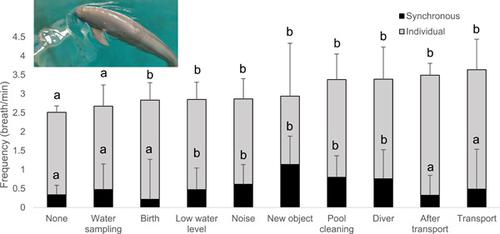Our official English website, www.x-mol.net, welcomes your
feedback! (Note: you will need to create a separate account there.)
Contextual impacts on individual and synchronous breathing rate variations in three captive odontocete groups
Zoo Biology ( IF 1.2 ) Pub Date : 2020-11-14 , DOI: 10.1002/zoo.21579 Agathe Serres 1, 2 , Yujiang Hao 1 , Ding Wang 1
Zoo Biology ( IF 1.2 ) Pub Date : 2020-11-14 , DOI: 10.1002/zoo.21579 Agathe Serres 1, 2 , Yujiang Hao 1 , Ding Wang 1
Affiliation

|
Breathing rates are often collected both in the wild and in captivity to inform on cetaceans' internal state. However, few studies have investigated the effect of various factors on this breathing rate. We investigated the variations of individual and synchronous breathing rates depending on individual features (species, sex, age), displayed behavior, social parameters (social grouping), and environmental parameters (diurnal variation, presence of enrichment, unusual events, and presence of visitors in three groups of captive odontocetes (Yangtze finless porpoises, Neophocaena asiaeorentalis asiaeorientalis, East-Asian finless porpoises, Neophocaena asiaeorentalis sunameri, bottlenose dolphins, Tursiops truncatus). Both individual and synchronous breathing rates were the highest when animals engaged in energetic or social behaviors. Individual breathing rate decreased but synchronous breathing rate increased with the presence of enrichment. Both rates increased during unusual events (e.g., pool cleaning, presence of a diver in the pool, noise, transport) and when public was present for Yangtze finless porpoises. Finally, synchronous breathing rate increased for Yangtze finless porpoises when experiencing social separation. We suggest that individual and synchronous breathing rates are useful parameters to measure, both in wild and captive animals, to obtain information on their arousal/stress state. However, these rates should be interpreted with caution and should be used together with other parameters to allow more accurate inferences.
中文翻译:

环境对三个圈养齿鲸组个体和同步呼吸频率变化的影响
通常在野外和圈养中收集呼吸频率,以了解鲸类的内部状态。然而,很少有研究调查各种因素对这种呼吸频率的影响。我们调查了个体和同步呼吸率的变化,这取决于个体特征(物种、性别、年龄)、表现出的行为、社会参数(社会分组)和环境参数(昼夜变化、富集的存在、异常事件和访客的存在)在三组圈养齿鲸(长江江豚、Neophocaena asiaeorentalis asiaeorientalis、东亚江豚、Neophocaena asiaeorentalis sunameri、宽吻海豚、Tursiops truncatus)中,无论是个体还是群居动物,在进行高能量呼吸时,个体和同步行为都是最高的。随着富集的存在,个体呼吸率降低,但同步呼吸率增加。在不寻常事件(例如,游泳池清洁、游泳池中有潜水员、噪音、运输)和公众出现长江江豚时,这两种比率都会增加。最后,长江江豚在经历社会分离时同步呼吸频率增加。我们建议个人和同步呼吸频率是测量野生和圈养动物的有用参数,以获取有关其唤醒/压力状态的信息。但是,应谨慎解释这些比率,并应与其他参数一起使用以进行更准确的推断。在不寻常事件(例如,游泳池清洁、游泳池中有潜水员、噪音、运输)和公众出现长江江豚时,这两种比率都会增加。最后,长江江豚在经历社会分离时同步呼吸频率增加。我们建议个人和同步呼吸频率是测量野生和圈养动物的有用参数,以获取有关其唤醒/压力状态的信息。但是,应谨慎解释这些比率,并应与其他参数一起使用以进行更准确的推断。在不寻常事件(例如,游泳池清洁、游泳池中有潜水员、噪音、运输)和公众出现长江江豚时,这两种比率都会增加。最后,长江江豚在经历社会分离时同步呼吸频率增加。我们建议个人和同步呼吸频率是测量野生和圈养动物的有用参数,以获取有关其唤醒/压力状态的信息。但是,应谨慎解释这些比率,并应与其他参数一起使用以进行更准确的推断。我们建议个人和同步呼吸频率是测量野生和圈养动物的有用参数,以获取有关其唤醒/压力状态的信息。但是,应谨慎解释这些比率,并应与其他参数一起使用以进行更准确的推断。我们建议个人和同步呼吸频率是测量野生和圈养动物的有用参数,以获取有关其唤醒/压力状态的信息。但是,应谨慎解释这些比率,并应与其他参数一起使用以进行更准确的推断。
更新日期:2020-11-14
中文翻译:

环境对三个圈养齿鲸组个体和同步呼吸频率变化的影响
通常在野外和圈养中收集呼吸频率,以了解鲸类的内部状态。然而,很少有研究调查各种因素对这种呼吸频率的影响。我们调查了个体和同步呼吸率的变化,这取决于个体特征(物种、性别、年龄)、表现出的行为、社会参数(社会分组)和环境参数(昼夜变化、富集的存在、异常事件和访客的存在)在三组圈养齿鲸(长江江豚、Neophocaena asiaeorentalis asiaeorientalis、东亚江豚、Neophocaena asiaeorentalis sunameri、宽吻海豚、Tursiops truncatus)中,无论是个体还是群居动物,在进行高能量呼吸时,个体和同步行为都是最高的。随着富集的存在,个体呼吸率降低,但同步呼吸率增加。在不寻常事件(例如,游泳池清洁、游泳池中有潜水员、噪音、运输)和公众出现长江江豚时,这两种比率都会增加。最后,长江江豚在经历社会分离时同步呼吸频率增加。我们建议个人和同步呼吸频率是测量野生和圈养动物的有用参数,以获取有关其唤醒/压力状态的信息。但是,应谨慎解释这些比率,并应与其他参数一起使用以进行更准确的推断。在不寻常事件(例如,游泳池清洁、游泳池中有潜水员、噪音、运输)和公众出现长江江豚时,这两种比率都会增加。最后,长江江豚在经历社会分离时同步呼吸频率增加。我们建议个人和同步呼吸频率是测量野生和圈养动物的有用参数,以获取有关其唤醒/压力状态的信息。但是,应谨慎解释这些比率,并应与其他参数一起使用以进行更准确的推断。在不寻常事件(例如,游泳池清洁、游泳池中有潜水员、噪音、运输)和公众出现长江江豚时,这两种比率都会增加。最后,长江江豚在经历社会分离时同步呼吸频率增加。我们建议个人和同步呼吸频率是测量野生和圈养动物的有用参数,以获取有关其唤醒/压力状态的信息。但是,应谨慎解释这些比率,并应与其他参数一起使用以进行更准确的推断。我们建议个人和同步呼吸频率是测量野生和圈养动物的有用参数,以获取有关其唤醒/压力状态的信息。但是,应谨慎解释这些比率,并应与其他参数一起使用以进行更准确的推断。我们建议个人和同步呼吸频率是测量野生和圈养动物的有用参数,以获取有关其唤醒/压力状态的信息。但是,应谨慎解释这些比率,并应与其他参数一起使用以进行更准确的推断。







































 京公网安备 11010802027423号
京公网安备 11010802027423号